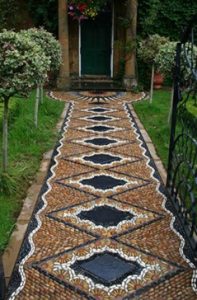
Unlike commercial landscaping, where path styling and material plays a significant role, many homeowners pay less attention when it comes to their garden paths and boardwalks, focusing instead on the practical need of providing a walking surface to approach their house…or the shed…or the yacht moored to their private jetty!
Garden paths can be more than just a practical solution for navigating one’s property. With a bit of creativity, you can transform your garden into an invitation to explore and enjoy every colourful nook and cranny, while adding interest and value to your home. And today, you have products that make for more creative pathway possibilities and offer safer navigation and zero maintenance, which we will explore here.
Consider Purpose
Consider the purpose of your garden path. Is it a practical link from the  front gate to the front door? Or to reach the garage? Or is its function purely decorative…perhaps to meander lazily through a colourful maze of hollyhocks, larkspur and lavender in your showpiece garden?
front gate to the front door? Or to reach the garage? Or is its function purely decorative…perhaps to meander lazily through a colourful maze of hollyhocks, larkspur and lavender in your showpiece garden?
Your choice of design and material will depend on your path’s purpose and location: practical and simple to avoid slips and trips in heavily trafficked areas or a creative work of art to add beauty. NewTechWood composite timber looks equally at home in a modern or rustic garden setting. With its natural timber look and feel and choice of natural colours, it is a favourite with landscapers who want to use timber but avoid all the hassles that go with real timber, i.e. warping, rotting, termites, splinters! You can match it easily to your decking, cladding or garden screening, too.
Does it Suit the Terrain
 Will your path be crossing carefully tended grass, lumpy moist-retaining surfaces, or just plain sand? Will it need to be stable in very wet weather? Will it be raised, or involve steps? Is the area level, uneven, rocky or sloped? Not all path materials are suitable for all terrains. Think of mud slides on sloping areas, and soft ground issues, for example. While smooth slabs of rock and polished pebbles add rustic appeal to a garden, in the wet they can become slippery and unstable surfaces, and not everyone appreciates the moss that is attracted to it.
Will your path be crossing carefully tended grass, lumpy moist-retaining surfaces, or just plain sand? Will it need to be stable in very wet weather? Will it be raised, or involve steps? Is the area level, uneven, rocky or sloped? Not all path materials are suitable for all terrains. Think of mud slides on sloping areas, and soft ground issues, for example. While smooth slabs of rock and polished pebbles add rustic appeal to a garden, in the wet they can become slippery and unstable surfaces, and not everyone appreciates the moss that is attracted to it.
Size Matters
Size matters depending on space available and your budget. In small spaces and light traffic areas, you can consider gravel with a few stepping stones. You don’t have to spend extravagantly to provide a pathway that is practical as well as eye-catching.
Plus there is little point spending a fortune on a path that winds all around the garden to link your laundry to the clothes line, especially as you’ll just end up cutting across the lawn on a more direct route!
Garden Paths Can Make a Statement
 The front path is one of the first things people see when they enter your property. Does your path scream dull and uninviting? Or does it welcome your visitors with the promise that a warm and thoughtful welcome awaits them?
The front path is one of the first things people see when they enter your property. Does your path scream dull and uninviting? Or does it welcome your visitors with the promise that a warm and thoughtful welcome awaits them?
If your budget is generous, your front path can be an amazing work of art, but at the other end of the scale, even the dullest concrete path can be rejuvenated with a border of colourful plants and a lick of paint.
If you can’t afford the amazing work of art, but the idea of a concrete path leaves you cold, consider a timber deck path that will add warmth and character to your garden. NewTechWood composite timber adds modern appeal to any garden, and with a 25-year warranty, you know it’s going to stand the test of time (and cost a lot less than the pebble masterpiece pictured here.)
Illusions are Good
 In modern suburbs where housing lots have become smaller, yard spaces have shrunk correspondingly. Don’t let this thwart your creativity.
In modern suburbs where housing lots have become smaller, yard spaces have shrunk correspondingly. Don’t let this thwart your creativity.
You can create the illusion of length or width in your yard by laying pavers or decking boards horizontally or longitudinally.
Consider using benches or garden statues at various points of your garden pathways for added interest.
Select groundcovers and winding pathways are creative and cost-effective, water-saving use of a small backyard instead of lawn.
Choice of Materials
Your choice of paving material will depend on its function and also needs to complement its surroundings – garden and architecture, colour and styling.
Natural Timber is at home in modern and rustic gardens, although you will have to consider regular maintenance needs and termites.
If your heart is set on timber, you can consider composite  products, such as NewTechWood, which looks like the real thing but is termite, UV and fade-resistant. It is also low-maintenance.
products, such as NewTechWood, which looks like the real thing but is termite, UV and fade-resistant. It is also low-maintenance.
Pavers will last and are also relatively maintenance free, but not all are non-slip and will attract moss in damp areas. They also stain easily due to their porous nature. Composite timber, like NewTechWood, looks great in modern and rustic settings and is stain resistant, thanks to its Ultrashield technology which provides 360 degree capping to protect the core.
Cement is a cheap option, although in time it will crack, fade, is hot to walk on and stains easily. On the other hand, it’s great for children’s bikes and skates. You can also spend more and have stamped concrete with or without colour. It is patterned to resemble paving, flagstones and tiles. However, some concrete surfaces, when painted, can be quite slippery when wet, even with a non-slip coating applied. NewTechWood composite timber has an R11 slip rating and is chosen for public walkways, boardwalks and parks internationally, so you know it’s safe.
Your cheapest path options are mulch, gravel or pebble. A popular look these days combines bluestone gravel interspersed with concrete pavers, but you can also replace the gravel with ground covers or small plants to add colour and interest. If you want the pebble look, go with crushed pebble as it is not as slippery. Another drawback with pebble is it tends to roll and travel and get caught in shoe soles.
 Mulch pathways look at home in natural and rustic garden settings. It’s the easiest and lightest material to work with and an obvious choice for the budget conscious. Some tree lopping services provide free mulch just so they can get rid of it. Just remember that beautiful red or black mulch you buy today will soon turn grey, and within a few years you will have to top it up as it will decompose. The beauty of a product like NewTechWood is it is fade resistant and testing has proven it will still be as beautiful in 25 years time as it is the day you buy it.
Mulch pathways look at home in natural and rustic garden settings. It’s the easiest and lightest material to work with and an obvious choice for the budget conscious. Some tree lopping services provide free mulch just so they can get rid of it. Just remember that beautiful red or black mulch you buy today will soon turn grey, and within a few years you will have to top it up as it will decompose. The beauty of a product like NewTechWood is it is fade resistant and testing has proven it will still be as beautiful in 25 years time as it is the day you buy it.
To stop your mulch or gravel material from spreading, you can use decorative edging, such as a row of small rocks, or a plastic or concrete edge that is readily available from any garden store. Landscape timbers also look great as a border in rustic settings.
Last, But Not Least: Safety
If you live in an area where there is a lot of rain or snow and ice, you need to be extra mindful of the type of material you use. A smooth pebble pathway may look extraordinary, but becomes impractical and downright dangerous in wet weather. Check for slip ratings, where applicable.
Do a risk assessment. Does it need to be child-friendly? You can avoid accidents by determining if toys like roller skates may be used safely or will snag in paving gaps, sending your precious offspring headfirst into the garden beds.
Will you be carrying washing baskets or equipment that impairs your vision of where you’re stepping? Choose a path that instils confident walking without the need to look where you’re placing your feet.
Then there is the little matter of shoe type. Stilettos appreciate a smoother, crevice free surface, whereas workman’s boots or everyday sandals are not so fussy about terrain.
Consider also different stride lengths and gait patterns – the paving needs of a tall adult are quite different to that of a child or shorter person if confronted with stepping stones. If your pathway is not level or presents any kind of hazard, consider garden lighting to assist visitors to find their way safely in poor light.
Do you live in a bushfire area? Don’t let that deter you from a rustic ‘timber’ look – NewTechWood composite timber comes with a BAL 29 fire rating!
And finally, whether your pathway needs are humble or grand, there is no denying that a carefully chosen pathway beats raw dirt any day!
